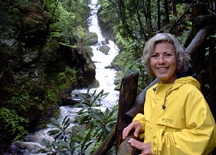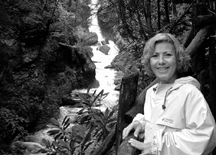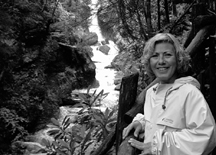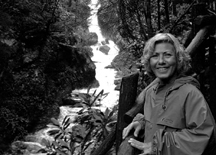
| |
|
NOTE BOOK: FULL COLOR (updated 1/24/04) As you may already be aware, I've been researching, developing, and actually doing these portraits for close to ten years now. For all practical purposes, the tutorials and modules that I've been placing in this section are more review and publication of techniques already tried and true. As time permits, I continue to work on further development, and much of that will be taking place at the same time as putting the tutorials up on the web. So, I thought I'd start an online notebook that would provide a sense as to where all this is at presently -- rather than just the publication of already-existing techniques. I've also been working with pseudo-color holography, i.e. triethanolomine techniques since 1985. Because of variations of color control with this, it is somewhat unreliable for both consistency and accurate color -- especially when Red, Green and Blue would have to be combined to form a full-color (or more appropriately termed "accurate" color) portrait. That being said and acknowledged, I don't think it's out of the ball park either. Of course, the ultimate recording choice for this would be with RGB diodes (or gas lasers as well). However, that is well out of the range at the present time for most amateur and hobbyist holographers. While this may not remain true several years from now, it is true today. And since I'm sitting here typing this today, not several years from now, I'm going to concentrate on a process that will possibly allow full-color portraits -- with already-existing equipment for most, and as usual, a little elbow grease.
Many of you will see the above photos and know where I'm going with this right away. For those of you who do not, let me first point out what it is you're looking at:
Now, I'm going to have to get one of my old color separation books down off the shelf to make sure, but I'm fairly certain that cyan, magenta and yellow filters are used to extract the red, green and blue information from color trannies. So don't quote me on that just yet. With that being said, the jist of this is to wind up with THREE laser transmission masters per hologram portrait, each being created using 8 individual frames of their respective colors. In other words, the mastering process would be exactly the same as with the "regular" portrait process, but you'd be making three masters: one for red, one for blue, and one for green. ALL of them registered perfectly -- both amongst themselves, and in relation to one another. Very similar to the way that CMYK plates are color separated and registered for offset printing. The question then becomes how to get the three sets of 8 frames with their respective colors extracted as you see above. There are certainly lens filters for this, but you would need three passes photographing the person during the shoot. Not likely. An easier method may be to extract the color from color transparancies, i.e. shooting with Kodak Ecktachrome. This would require a slide duplicator, which is a device that replaces the lens on your camera. You place each slide into the holder at the end, point toward a strong light source (color corrected light source of course), then snap your pictures onto TMAX100 as usual. If the filters could be placed between the slide duplicator and the camera, we'd be good to go. Once the TMAX100 is reversal processed, we wind up with three sets of 8 positive exposures for each of the three colors: red, green and blue. Masters would be made as usual, keeping strict attention to registration (an absolute must). The reflection copy would be done using three exposures: one exposure for each of the master plates. In between exposures, the plate would be soaked in its respective concentration of triethanolomine for the three colors. When the reflection hologram is processed, dried, and illuminated, a full-color portrait will be waiting. For those not familiar with the TEA process, all exposures are shot with one wavelength, i.e. 633 for HeNe, 650 for diode and so on. It's a very interesting process, and quite a learning experience unto itself for understanding how the emulsion selects and reconstructs multiple wavelengths in one hologram. Recording geometries would also have to be adjusted for each color. If not, the colors in the hologram will be out of registration when illuminated. This isn't the end of the world however, and we're not talking about having a completely new set-up for each transfer. Just a geometric change in the reference beam angle. More on this later. As stated above, the only drawback is the accuracy of the color -- mostly through the concentration levels of triethanolomine in each pre-treatment solution. This would have to be determined as closely as possible by trial-and-error on test plates of perhaps just plain laser light. There are many hues of red, green and blue -- and each would have to be the proper one or final color will be off -- similar to a badly-adjusted television. But this is not impossible, and once determined, that would be that. A second drawback, and perhaps one that would be easier to solve, is the fact that I've noticed that pseudocolor reflection holograms change color as humidity levels rise and fall. My own color reflections show very deep reds in the humid summer months (emulsion expanding), but the deep reds go to almost a reddish-orange during the dry winter months (emulsion contracting) . . . inside temp. remaining the same. But this may be solved by a good sealant. It doesn't make too much of a difference when the image is composed of random areas of color -- but would stick out like a sore thumb when color would have to be combined into providing a full-color RGB image. So these are my thoughts tonight. Time to sleep on them, and put them on the back burner for a good simmer. Thoughts and comments always welcome: director at holoworld dot com. As always, Frank NEXT SECTION: Correcting the inaccuracies of triethanolomine-based, pseudocolor reflection holograms through digital manipulation of RGB spot-color separations.
|



